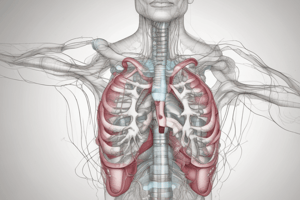Podcast
Questions and Answers
What is the primary function of the blood-air barrier in the lungs?
What is the primary function of the blood-air barrier in the lungs?
- To prevent air bubbles from forming in the blood and blood from entering the alveoli (correct)
- To filter out bacteria and particles from the air
- To facilitate the exchange of oxygen and carbon dioxide
- To regulate blood pressure in the pulmonary circulation
What is the approximate diffusion distance for oxygen and carbon dioxide in the pulmonary capillaries?
What is the approximate diffusion distance for oxygen and carbon dioxide in the pulmonary capillaries?
- Five times the diameter of a red blood cell
- The diameter of a red blood cell
- Less than the diameter of a red blood cell (correct)
- Twice the diameter of a red blood cell
What is the role of elastic fibers in the pulmonary interstitial space?
What is the role of elastic fibers in the pulmonary interstitial space?
- To maintain lung elasticity and prevent collapse (correct)
- To filter out bacteria and particles from the air
- To facilitate the exchange of oxygen and carbon dioxide
- To regulate blood pressure in the pulmonary circulation
What is the origin of pulmonary macrophages?
What is the origin of pulmonary macrophages?
What is the purpose of the anastomosis between the bronchial and pulmonary capillary beds?
What is the purpose of the anastomosis between the bronchial and pulmonary capillary beds?
What is the thickness of the blood-air barrier in the lungs?
What is the thickness of the blood-air barrier in the lungs?
What is the primary function of the 'air-blood barrier' in the lungs?
What is the primary function of the 'air-blood barrier' in the lungs?
What is the approximate total surface area of the alveoli in both lungs?
What is the approximate total surface area of the alveoli in both lungs?
What is the primary role of Type II alveolar cells?
What is the primary role of Type II alveolar cells?
How many alveoli are approximately found in each lung?
How many alveoli are approximately found in each lung?
What is the characteristic shape of Type I alveolar cells?
What is the characteristic shape of Type I alveolar cells?
What percentage of the total alveolar surface area is covered by Type I alveolar cells?
What percentage of the total alveolar surface area is covered by Type I alveolar cells?
What is the primary function of the pulmonary circulation?
What is the primary function of the pulmonary circulation?
Which of the following veins receives blood from the right bronchial veins?
Which of the following veins receives blood from the right bronchial veins?
What is the characteristic of the pulmonary artery in terms of pressure?
What is the characteristic of the pulmonary artery in terms of pressure?
What is the direction of the right pulmonary artery?
What is the direction of the right pulmonary artery?
What is the origin of the pulmonary trunk?
What is the origin of the pulmonary trunk?
What is the path of the pulmonary trunk after it arises from the right ventricle?
What is the path of the pulmonary trunk after it arises from the right ventricle?
What is the main characteristic of the left pulmonary artery?
What is the main characteristic of the left pulmonary artery?
What is the primary function of the pulmonary veins?
What is the primary function of the pulmonary veins?
What is the location of the bronchomediastinal lymph nodes?
What is the location of the bronchomediastinal lymph nodes?
What is the primary function of the lobar arteries?
What is the primary function of the lobar arteries?
Where do the bronchomediastinal lymph nodes drain into?
Where do the bronchomediastinal lymph nodes drain into?
What is the characteristic of lymphatic vessels in the lung?
What is the characteristic of lymphatic vessels in the lung?
What is the primary function of the parasympathetic fibers in the pulmonary plexus?
What is the primary function of the parasympathetic fibers in the pulmonary plexus?
During inspiration, which muscle is responsible for increasing the vertical thoracic diameter?
During inspiration, which muscle is responsible for increasing the vertical thoracic diameter?
What is the primary mechanism of expiration in the respiratory cycle?
What is the primary mechanism of expiration in the respiratory cycle?
Which nerve provides the parasympathetic fibers to the pulmonary plexus?
Which nerve provides the parasympathetic fibers to the pulmonary plexus?
What is the proportion of air entering the lungs due to the contraction of the intercostal muscles?
What is the proportion of air entering the lungs due to the contraction of the intercostal muscles?
What is the source of the sympathetic fibers in the pulmonary plexus?
What is the source of the sympathetic fibers in the pulmonary plexus?
Flashcards are hidden until you start studying




